activities
←exhibition Radioscapes Symposium at the Noorderlicht Biennale, Groningen August 2025
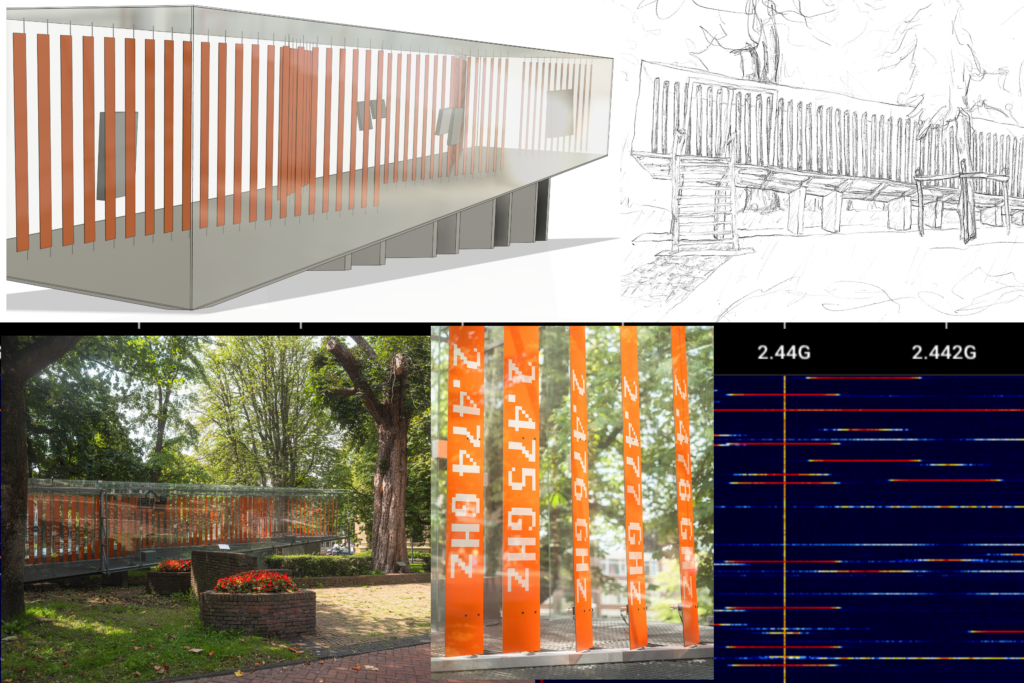
August 31, 2025 at Noorderlicht Biennale, Akerkhof 12, 9711 JB Groningen
Organisers
- Christy Westhovens
- Noorderlicht photography biennale
- critical infrastructure lab
- Kunstpunt Groningen
We constantly move through a sea of radio signals. Wi-Fi, Bluetooth, cell towers and satellites form an invisible landscape that permeates our everyday lives. These electromagnetic waves shape how we communicate, move and live together — and yet, we never see them.
With Signals of you, her installation at the Tschumipavilion, Christy Westhovens makes this hidden network tangible. The red panels respond to Bluetooth signals emitted by our devices, revealing how we continuously broadcast digital traces. The pavilion becomes an archive of daily presence, showing how infrastructure and behaviour together shape urban space.
The Radioscape Symposium offers a deeper exploration of this work. Bringing together artists, scholars and critical voices, we will reflect on how radio signals construct public space. What role do we play in these digital environments? Who has access to these invisible layers, and who is excluded? And what does it mean to render such ubiquitous but hidden signals visible?
Programme
- 12:00—13:00 Visit: Noorderlicht Biënnale, Niemeyerfabriek, Paterswoldeweg 43, Groningen
- 13:30—14:30 Data walk and visit Signals of you, Het Tschumipaviljoen van Kunstpunt, Hereplein, Groningen
- 16:00—18:00 Symposium, Noorderlicht, Akerkhof 12, Groningen
- Introduction by Christy Westhovens
- Roundtable with artists, researchers and guests
- Discussion with Q&A
A manifesto has been released in conjunction with the event.
Photos by Sebastiaan Rodenhuis.
This program is made possible through funding of Mondrian Foundation, Fonds 21, Stimuleringsfonds voor Creative Industrie.
Lineup
- Arthur Elsenaar >> Artist and teacher at ArtScience Interfaculty,
Hogeschool der Kunsten Den Haag (KABK/KonCon)
- Christy Westhovens >> Artist and researcher, Technology, Performance and
Society research unit, University of Music and Theatre Munich (HMTM)
- David Gauthier — moderator >> Artist and Assistant Professor of
Computational Media and Arts, Utrecht University (UU)
- Gabriel Pereira >> Assistant Professor in AI & Digital Culture, University
of Amsterdam (UvA)
- Juli Laczkó >> Artist and teacher at HKU Media, Image and Media
Technology, Hogeschool voor de Kunsten Utrecht (HKU)
- Maxigas >> Co-principal investigator, critical infrastructure lab;
Assistant Professor of Computational Methods, Utrecht University (UU)
- Niels ten Oever >> Co-principal investigator, critical infrastructure lab;
Assistant Professor, European Studies, University of Amsterdam (UvA)
- Pawan Seshadri Venkatesh >> CTO, UrbanVind
Photos by Sebastiaan Rodenhuis.

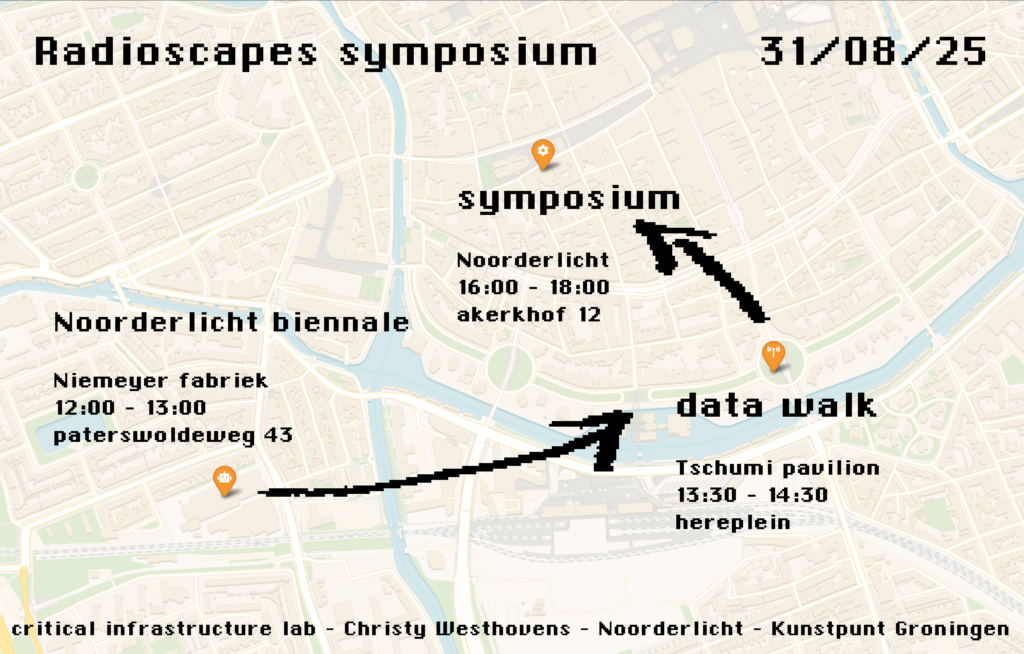
infrastructure walk data center walks and infrastructure walks February 2025
Join us for amateur exploration into the visibility of wireless equipment and services dotted around the city! We collectively map, observe and measure the techno-diversity of digital infrastructure in urban spaces. Data and infrastructure walks are a creative method and a social practice, which can be used to reflect on data power through critical infrastructure studies. It serves a variety of purposes, from public engagement, education, and artistic research to empirical studies.
Data center walks
We started data center walks with a simple question about how to make the invisible visible. People tend to forget about the infrastructure that lies beneath the data. For instance, the cloud remains a concept reduced to a depiction of a cloud, stripping data from its materiality. We usually do not see data centers, nor do we think about them in a material sense. By taking groups into data centers with us, we explore the resources, politics, and human labor that sustains them. To do so, we walk around and inside the data centers, observing physical traces as well as user-generated information online.
Infrastructure walks
We hold a series of “infrastructure walks” in Amsterdam and Berlin, exploring the visibility of digital infrastructures deployed in public spaces. The experience allows us to uncover data flows and to study datafication in urban areas. By engaging with the infrastructures around us, we seek to expose reconfigurations of power relations in the city through emerging technologies and protocols. Infrastructure walks address the question of what media technologies may mean “after all”, that is in the context of the life world, lived experiences and action possibilities of end users as embodied citizens. Insights can countermap the spatial control exercised through the electromagnetic spectrum in urban spaces. Often, us and the groups find that infrastructures should be (1) noticeable, (2) observable, (3) contestable or programmable to their users.
Upcoming walks and related events: Data Walk Workshop: Sensing Digital Materiality in Urban Public Spaces
Walking the infrastructure walk and dancing the frequency dance — You only see it when you get it
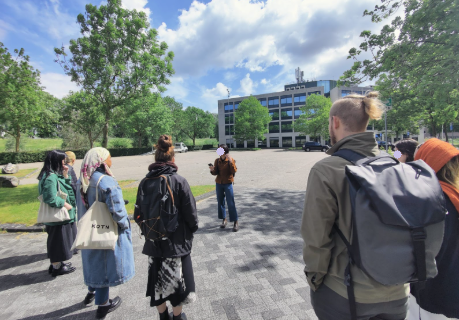
infrastructure walk “Data Walk as Method” at the Data Power Conference in Graz/Bangalore September 2024
Talk in the panel BP3: Reimagining Data (in Bangalore location), Friday 09:00 CEST, 12:30 IST, room B-RM R305.
The proposed panel brings together scholars and artists for methodological reflections on data walk as an empirical method and social practice. Data walk as a method emerged recently as a creative method employed by academics and artists for a variety of purposes from public engagement and project-based education to artistic research, or as a means of data collection for straightforward empirical studies. Loitering in urban public spaces of data infrastructures as a way to check our assumptions about more abstract notions of data power is the sensitivity that may connect these approaches. Nonetheless, the sensitivities go back historically and philosophically to the works of Walter Benjamin on the flaneur, the Situationist International on psychogeography, and to hacker practices such as wardriving.
After the fervent period of experimentation that describes the last few years, does it make sense now to discuss classical methodological issues such as canonisation, normative criteria, or the affordances and limitations of the interpretative power of the data walk methodology? In other words, what is a programmatic data walk? What is a successfully performed data walk? What data walks are suitable to address what epistemological questions? Which uses are there for data walks in academic life and artistic research?
A symposium on the topic is to be held Sprint 2025 at the University of Utrecht, bringing the results of the discussion at the data power conference to dedicated practitioners.
infrastructure walk infrastructure walk berlin – september 2022 September 2022
infrastructure walk Walking the infrastructure walk and dancing the frequency dance — You only see it when you get it April 2022
This post was written by Jeroen Matthijs de Vos, Niels ten Oever, and Maxigas. This event is a collaboration between the UvA, the Amsterdam municipality, and the ObA, it was made possible by Global Digital Cultures and IN-SIGHT.it (grant MVI.19.032 as part of the MVI programme).
The IN-SIGHT.it People’s 5G Lab, together with the Amsterdam public library, organised a so-called “infrastructure walk” at the Bijlmer ArenA on Saturday, March 26. The goal of the walk was to uncover data flows in the city (Parks & Starosielski, 2015). Twenty-two people joined the walk to study datafication in urban areas.
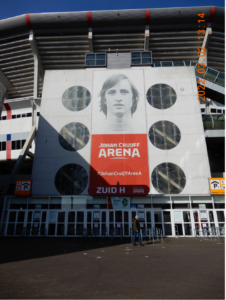
In the walk, participants used their eyes, ears, binoculars, spectrum analysers, and smartphones apps to see how people- and data-flows are organised within public spaces and in the context of the built environment. The Dutch football player-philosopher Johan Cruyff (Figure 1) once said: “You only get it when you see it.” In line with this aphorism, the participants in the infrastructure sought “to get” the logics of infrastructural and architectural control.
A “Digital Perimeter” has been established around the Johan Cruyff stadium in preparation for the Eurocup in 2019 with the aim to “make people feel safer in crowds.” This digital control zone is a public-private partnership with the collaboration of the Amsterdam ArenA, the Amsterdam municipality, the Dutch police, and TNO. Part of the project was the experimental roll-out of 5G networks, which drew the attention of our research group to the site.
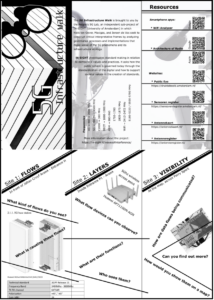
Before the infrastructure walk took place, the organisers conducted several field surveys to map out the routers, devices, antennas, cameras, gates, and sensors that enable connectivity, safety services and facilitate crowd control within the area. A handout (Figure 2) was created with an overview of devices and a list of radio-magnetic frequencies on which those devices operate. During the infrastructure walk, the participants relied on these clues to look for devices, identify their make and model, and make informed guesses about their purpose and ownership. The group discussed how they work, and who has access to these data flows.
The impromptu analysis by the participants shows a complex layering of telecommunications protocols in use within the surroundings. We found 4G, 5G, WiFi, DECT, Bluetooth, C2000 (emergency services) networks, owned and operated by a variety of stakeholders including mobile communication providers, the police, the municipality, and the Amsterdam ArenA. A poster (Figure 3) of the Dutch Frequency Landscape as well as the website antennekaart.nl helped to map out who has access to which data, and what the capabilities of these radio devices are.
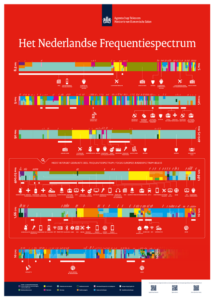
Police officers on patrol also took a keen interest in the ongoing investigations. We learned that while it is accepted for many different institutions to observe the general public, the reverse, also known as “sousveillance” (Mann, Nolan, & Wellman, 2018), is not generally accepted. Only when the organisers disclosed their affiliation with the University of Amsterdam and the Public Library could they resume their research. This echoes the stark reality of spectrum allocations and frequency licensing: the electro-magnetic spectrum is an inherent part of public space, yet very narrow frequency bands are allocated for free public use. With the advent of the next generation mobile networks such as 5G, telecommunication providers ask for more spectrum exclusively allocated to them, mediating even more data flows.
The participants reflected on the city where public space is shaped by the requirements of the telecom industry and crowd control. Technological progress means that many new devices are introduced into the built environment, such as those that count the amount of people in spaces, a technique that becomes ever more granular each decade. For example, participants found old devices dating back to the 1960s space age, that count people by using lasers (Figure 4), whereas new devices are capable of more complex and sometimes controversial technologies such as facial recognition begging the question whether new is always better.
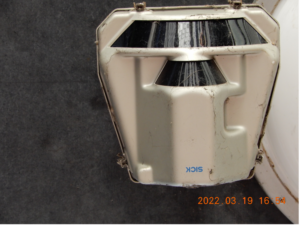
A main point of interest has been the particular ways these data infrastructures looked in the context of the built environment, and how their institutional owners informed the public about their purpose and mission, especially in terms of being open to dialogue. It proved surprisingly cumbersome to use the phone numbers that are supposed to inform people about surveillance. Stickers below the aforementioned Public Eye cameras rang at the general help desk of the Amsterdam municipality. When this number was called the operator responded that “this is not a tourist service“. Similarly, street signs advising on surveillance cameras used by the police also point to the general phone number for police inquiries. Finally, the Amsterdam ArenA itself does not provide any particular information about the use of CCTV, antennas, or systems outside the arena — at least not that we encountered.
At the end of the walk, the participants mapped out their findings on a public display (Figure 5). This started discussions on improving the public communication about data infrastructures in public spaces. The People’s 5G Lab will follow up on these ideas in our next engagements with citizens and policy makers.
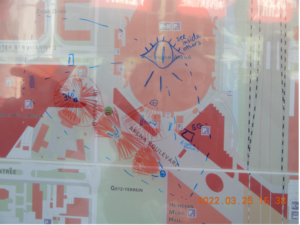
The infrastructure walk shows how infrastructure tends to “fade into the woodwork” (Star & Bowker, 2006), but that careful and persistent visual observation, frequency spectrum analysis, field interviews and desktop research can make it visible, and lead to hard questions about accountability and the use of public space.
References
Mann, S., Nolan, J., & Wellman, B. (2018). Sousveillance: Inventing and using wearable computing devices for data collection in surveillance environments. In T. Mohanan & D. Muramaki Wood (Eds.), Surveillance studies: A reader (pp. 347–350). New York, NY: Oxford University Press.
Parks, L., & Starosielski, N. (Eds.). (2015). Signal traffic: Critical studies of media infrastructures. The geopolitics of information. Champaign, IL: University of Illinois Press.
Star, S. L., & Bowker, G. C. (2006). How to infrastructure. In L. A. Lievrouw & S. Livingstone (Eds.), The handbook of new media (Updated Student Edition., pp. 230–245). London: Sage.








